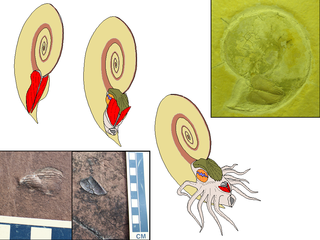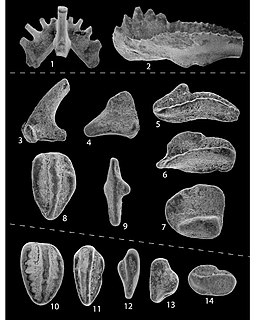Related Research Articles

Conodonts are an extinct group of agnathan (jawless) vertebrates resembling eels, classified in the class Conodonta. For many years, they were known only from their tooth-like oral elements found in isolation and now called conodont elements. Knowledge about soft tissues remains limited. They existed in the world's oceans for over 300 million years, from the Cambrian to the beginning of the Jurassic. Conodont elements are widely used as index fossils, fossils used to define and identify geological periods. The animals are also called Conodontophora to avoid ambiguity.

An aptychus is a type of marine fossil. It is a hard anatomical structure, a sort of curved shelly plate, now understood to be part of the body of an ammonite. Paired aptychi have, on rare occasions, been found at or within the aperture of ammonite shells. The aptychus was usually composed of calcite, whereas the ammonite shell was aragonite.
The Pander Society is an informal organisation founded in 1967 for the promotion of the study of conodont palaeontology. It publishes an annual newsletter. Although there are regular meetings of the Pander Society, at the Annual Meeting of the Geological Society of America, at European Conodont Symposia, and elsewhere, any meeting of three or more "Panderers" is considered an official meeting of the "Pander Society". The society is headed by the Chief Panderer, currently Maria Cristina Perri of the Università di Bologna. The society confers two awards, the Pander Medal for a lifetime of achievement in conodont palaeontology, and the Hinde Medal for an outstanding contribution to conodont palaeontology by a young Panderer.

Archeognathus is a fossilized jaw apparatus of a large predatory conodont from the Ordovician period. Its large size has made classification difficult, and it has historically been compared to conodonts and gnathostomes since its remains were first discovered in Missouri. Complete articulated jaw apparatus of Archeognathus primus are common in the Winneshiek Shale lagerstätte of Iowa, allowing its identity as a conodont to be secured.
Prioniodontida, also known as the "complex conodonts", is a large clade of conodonts that includes two major evolutionary grades; the Prioniodinina and the Ozarkodinina. It includes many of the more famous conodonts, such as the giant ordovician Promissum (Prioniodinina) from the Soom Shale and the Carboniferous specimens from the Granton Shrimp bed (Ozarkodinina). They are euconodonts, in that their elements are composed of two layers; the crown and the basal body, and are assumed to be a clade.
Cordylodontidae is a family of conodonts.
Proconodontida is an order of conodonts.

Polygnathus is an extinct genus of conodonts.
Palmatolepis is an extinct conodont genus in the family Palmatolepidae. It was the most abundant genus of conodonts of the Late Devonian, disappearing during the Devonian/Carboniferous crisis.
Proconodontidae is an extinct family of conodonts in the order Proconodontida.
Gondolellidae is an extinct family of conodonts in the order Ozarkodinida. There are three subfamilies: Mullerinae, Neogondolellinae and Novispathodinae.
Pterospathodus is an extinct genus of conodont from the Silurian period.
Idiognathoides is an extinct genus of conodonts.
Misikella is an extinct genus of conodonts.
Cryptotaxis is an extinct genus of conodonts in the family Cryptotaxidae from the Famennian.
Gilbert Klapper is a paleontologist.
Scotlandia is an extinct genus of conodonts in the family Prioniodinidae.

The conodont feeding apparatus is a series of phosphatic-mineralized elements, resembling a set of “teeth”, which are found lining the oral surface of the conodont animal.

The Winneshiek Shale is a Middle Ordovician (Darriwilian-age) geological formation in Iowa. The formation is restricted to the Decorah crater, an impact crater near Decorah, Iowa. Despite only being discovered in 2005, the Winneshiek Shale is already renowned for the exceptional preservation of its fossils. The shale preserves a unique ecosystem, the Winneshiek biota, which is among the most remarkable Ordovician lagerstätten in the United States. Fossils include the oldest known eurypterid, Pentecopterus, as well as giant conodonts such as Iowagnathus and Archeognathus.

Panderodus Is an extinct genus of jawless fish belonging to the order Conodonta. This genus had a long temporal range, surviving from the middle Ordovician to late Devonian. In 2021, extremely rare body fossils of Panderodus from the Waukesha Biota were described, and it revealed that Panderodus had a more thick body compared to the more slender bodies of more advanced conodonts. It also revealed that this conodont was a macrophagous predator, meaning it went after large prey.